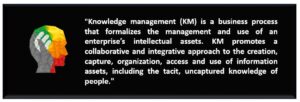Introduction
Knowledge Management (KM) defines a set of systematic and disciplined activities that organizations undertake to obtain the optimum value from the knowledge assets under their ownership and control. KM's principal business goal is to provide the right contextual knowledge to the right people on demand to help people share experiences and insights, make better decisions, and improve their and teammate productivity.
The term Knowledge Management (KM) entered the business lexicon in the early 1980s primarily introduced by management gurus and consultants and the top computer companies of the day. In this and future periods, Peter Drucker, Peter Senge, and Paul Strassmann most notably published and continually spoke about the value of information and knowledge as mission-critical resources and how 'learning organizations' were crucial drivers to leverage and exploit positive enterprise culture effectively.
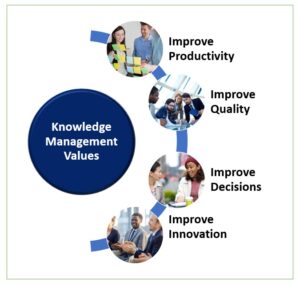 The KM values highlighted in the nearby graphic propelled attraction and adoption across broad segments of most industries. These values have continued to support a history of success stories validating the benefits of creating and supporting organizational cultures with a knowledge management strategic focus.
The KM values highlighted in the nearby graphic propelled attraction and adoption across broad segments of most industries. These values have continued to support a history of success stories validating the benefits of creating and supporting organizational cultures with a knowledge management strategic focus.
The KM principles espoused by the early evangelists have remained unchanged over the years, albeit enhanced with the emergence of new technologies.
These tenets involved and impacted conventional workplace processing, initiatives, and programs and encompassed culture, strategy, infrastructure, technology, and learning. In these early days, many companies were intrigued by the prospects of significant processing and productivity improvement to impact profitability. However, technology had not yet caught up to theory, resulting in the lack of the necessary solutions to automate processing for effectively managing the tacit and explicit knowledge contained in the employee population minds and PC files, emails, and business unit silo databases. In this period, technologies were sadly unavailable or sufficiently mature to deliver the promised benefits of enterprise-wide KM.
By 1990, an array of the top U.S., European, and Japanese management consulting firms successfully established KM programs for both internal use and as services offered. In 1993, as a KM champion, Peter Drucker contended "that land, labor, and capital, the classical factors of production, have been largely replaced by knowledge and that knowledge has become the resource, rather than a resource, is what makes our society post-capitalist." The highly-acclaimed "The Knowledge-Creating Company: How Japanese Companies Create the Dynamics of Innovation," by Ikujiro Nonaka and Hirotaka Takeuchi, published in 1996, upheld that "In an economy where the only certainty is uncertainty, the one sure source of lasting competitive advantage is knowledge."
In recent years, digitalization has created an undeniable creation of more content varieties. Large numbers of audio, video, and big data files populate the organizational Cloud and on-premise databases, making discovering and processing relevant information and knowledge more difficult and time-consuming for the workforce.
The Cloud and web-based networks are inherently social facilitators that link people, organizations, and the necessary knowledge. Once tantamount with dense and bounded neighborhood groupings, an online community is now a less bounded social network of workplace connections that provide potential helpfulness, information, and collaboration. As the division between personal and work life vanishes, employees will communicate in all possible digital-based ways with overlaps inherently possible. To enable more effective knowledge sharing, people need the ability to forge useful business links outside the natural business and social groupings throughout the organization. As a result, it is apparent that the conventional 'create and push' information approach is outdated in the modern workplace.
In many ways, these conditions point to the need for and adoption of a seamless interconnected collaboration platform that can improve the productivity and quality of employee and customer interactions. The shift from traditional end-to-end processes enables the cultural changes necessary for the modern workplace practices that need to represent five generations of workers.
The graph below depicts the original KM principles within an overlay of present-day business thinking and approach to employee communications and collaboration within the Knowledge Management Environment Model.
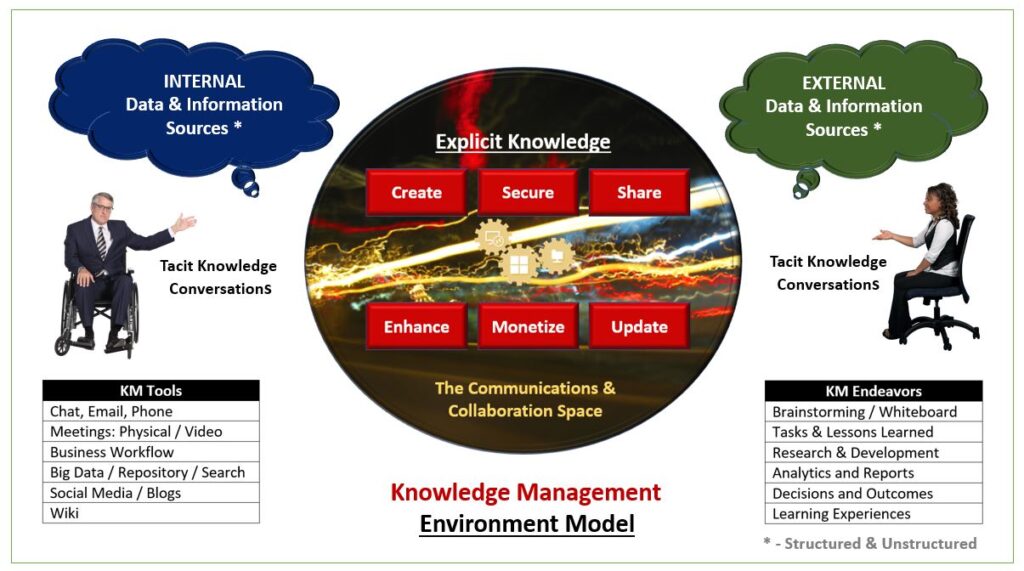
“Knowledge is theory. We should be thankful if action of management is based on theory. Knowledge has temporal spread. Information is not knowledge. The world is drowning in information but is slow in acquisition of knowledge. There is no substitute for knowledge.”
W. Edwards Deming
The Modern Workplace and Knowledge Value
In bygone days the work location was a physical site that employees inhabited during customary office hours. Now employees need to be always connected and access their work activities with any digital device. This new environment has obscured the divide between the traditional 'bricks and mortar' office, and where work happens and the home setting.
In this context, the workplace is evolving to be more mobile, streamlined, and social-based to support changing customer and competitive demands. This transformation recognized in business and academic circles as the 'Modern Workplace' represents an approach that advances integrated digital communications and collaboration as the new work paradigm. Successful workplace modernization will only occur upon an organization's acceptance and investment in building advanced communication and collaborative workplace supported with the required technology.
The modern workplace is affected by an array of human and technology demands that pronounce the end of traditional working practices within the 9 by 5 model. In this new and technology-driven environment, organizations need to effectively blend their employee's lifestyle requirements with a productive work environment resulting in a win-win for all stakeholders. Research supports that the prime characteristics of the Modern Workplace presented in the below graphic.
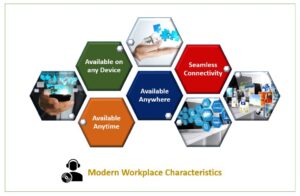
The essential premise of the modern workplace is that employees can seamlessly and intuitively connect, communicate, and collaborate with colleagues throughout the enterprise with the appropriate systems and tools. KM-focused technologies are crucial enablers for improving the workplace, meeting enterprise goals, and realizing the benefits of human resource and financial investments. The development of a workplace strategy that articulates its business focus and guides the workplace's re-engineering and deployment efforts ensures successful outcomes.
The activities typically included in a strategic workplace plan are highlighted in the below table.

“Human language is the new UI layer, bots are like new applications, and digital assistants are meta apps. Intelligence is infused into all of your interactions.”
Satya Nadella
The Microsoft Teams Solution
Gartner's KM definition below represents an excellent mission statement for organizations to consider in reengineering their workplaces to meet current-day business and technology challenges.
A collaboration platform that supports Gartner's modern-day KM definition, and has attracted widespread global interest is Microsoft's Teams, currently with over 75 million daily active users worldwide, in April 2020. Teams provide the capabilities for effective internal and external collaboration and the productive handling of explicit and tacit knowledge as prescribed or similar to long-established KM principles.
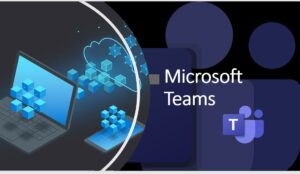 The Teams solution is inclusive, open, and designed for a workplace where five generations of workers are teaming up to work together. Typically 80 percent of the average working time is engaged in collaboration and information and knowledge-handling and requires an environment built on the Modern Workplace principles.
The Teams solution is inclusive, open, and designed for a workplace where five generations of workers are teaming up to work together. Typically 80 percent of the average working time is engaged in collaboration and information and knowledge-handling and requires an environment built on the Modern Workplace principles.
Microsoft Teams is a shared workspace that brings collaboration and communication solutions within Microsoft 365 into a focused workspace. It integrates with other Microsoft solutions, third-party vendors, and in-house development to facilitate faster and smarter work both within and outside the organization. With Teams, every worker type from the first line worker to the C-suite contributes their knowledge and insights and shares accountability for decisions, and business outcomes.
There are some resources absent in Teams, though, the ability to purchase third-party and build and integrate software and Bot extensions within Teams should eliminate most operating drawbacks and provide additional functional workplace richness. Also, the availability of Microsoft AI, machine learning, and natural language products represents significant value-adds for maximizing the KM benefits with Teams.
Teams enable organizations to make knowledge easily and intuitively accessible, connected to cross-functional teams without borders, and encourage leveraging and exploiting knowledge aligned with organizational goals and strategies.
For many users, teams are a radical departure from traditional interactions with colleagues and others by way of specific tools such as email, video conference, and phones. As with any new technology product, the best practices still lack maturity and development. However, Microsoft and the large user base have created excellent reference lessons learned for key capabilities and use.
In today's global work environment, organizations and their employees must effectively communicate across different locations, time zones, and languages to drive their businesses forward. Microsoft Teams puts everything organizations need—chats, meetings, calling, and Office 365 apps—to make faster, more informed decisions in a single, intelligent hub.
“Overall, customers were pleased with Teams and how well it integrates with the rest of Office 365. They cited associated cost savings as a key factor in adopting Teams. For a standard 5,000-user organization, the study reported benefits and costs of roughly $30.3 million and $3.3 million respectively, resulting in an overall net benefit of $27.1 million over three years.”
Forrester Study: The Total Economic Impact™ Of Microsoft Teams
Microsoft Team and Knowledge Management
Traditionally, the private and public sector, for the most part, discouraged working remotely from home settings. As a result of COVID-19, remote workplace practices are now being revisited and growing in strategic value and acceptance as a best practice. Modern technology-driven workspaces, built across the enterprise, remove unnecessary silos and 'sacred cow' considerations while enhancing productivity and deliverables by focusing on improved communications and collaboration.
As organizations transform their businesses with Cloud and emerging technologies, they quickly find new and more useful interaction methods, customer engagement, and effective ways to measure productivity and sales effectiveness.
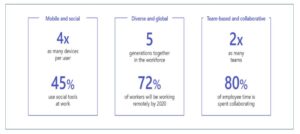 Recent Microsoft research, presented in the nearby graphic, provides testimony for the acceptance and wide-scale need for integrated workplace collaboration platforms and services.
Recent Microsoft research, presented in the nearby graphic, provides testimony for the acceptance and wide-scale need for integrated workplace collaboration platforms and services.
The structures, policies, and strategies for establishing domain or functional-based remote teams align with the long-established knowledge management principles. In many ways, technology has finally caught up with the tools required to successfully create, deploy, and support a high-value knowledge-based strategy with a robust supporting ecosystem.
The Teams solution satisfies substantial innovative workplace needs with the embedded software capabilities and the availability of additional apps and bots provided as extensions by Microsoft and other providers for seamless integration or interface. The majority of Teams capabilities offer an endorsement of the knowledge management principles, as shown below.
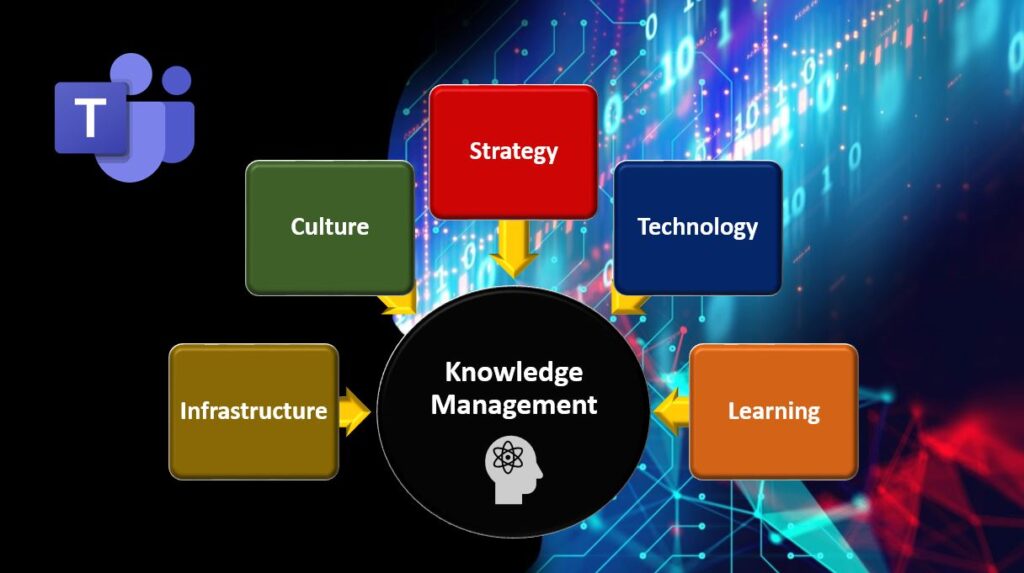
"Information is data endowed with relevance and purpose. Converting data into information thus requires knowledge. And knowledge, by definition, is specialized."
Peter Drucker
Culture
Organizational culture is a set of implied assumptions accepted by its members that determines their behavior and reactions to the surrounding environment. A knowledge-focused culture represents a positive workplace environment that promotes knowledge generation, sharing, leveraging, and exploiting organizational goals and strategy and cultivates a shared belief on the mission-critical value for organizational success. In this view, culture is an acquired body of knowledge whose interpretation and understanding provide the organization's identity and a sense of shared identity. A productive KM culture requires a correlation with the current enterprise culture as any daylight will result in uncertainty and delayed or non-acceptance.
The key characteristics of a healthy knowledge culture include:
- Purpose-driven enterprise
- Growth and development
- Employee engagement and loyalty
- Teamwork and collaboration
- Effective communication patterns
- Values and rewards feedback
Without a culture foundation, systemizing KM is unlikely to gain traction with the targeted employee population. The introduction of a new KM technology solution commonly requires a change or reinforcement of the existing culture. The hallmarks of a successful best practice's knowledge-focused culture generally exemplify the below.

The design goals and capabilities of Teams, as defined below, facilitate the deployment, adoption, and continual acceptance and support of a culture that empowers productive and quality knowledge handling across the enterprise.
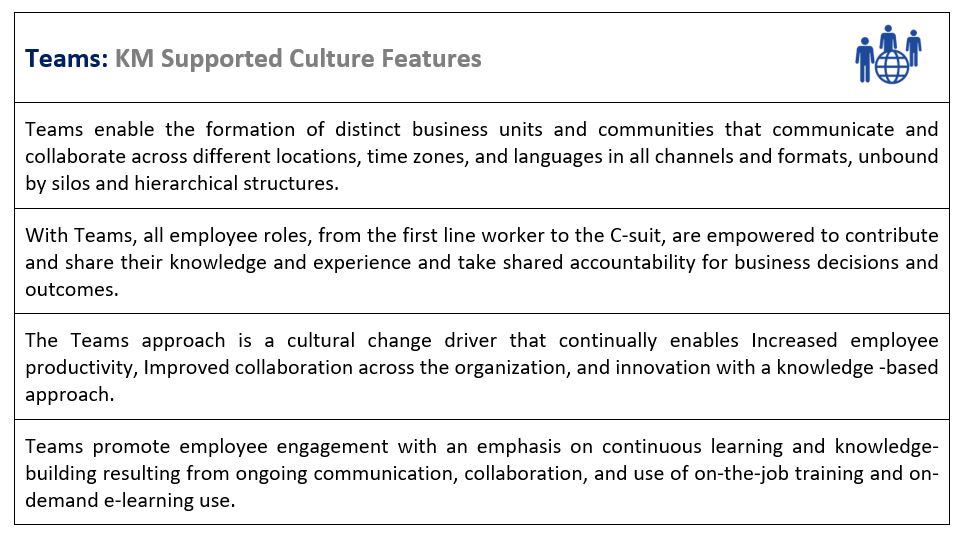
The transitioning to a new technology platform requires culture changes in the way people work, communicate, and collaborate. The attractiveness of Teams can be traced to the use of the familiar interface of Microsoft Office 365, making many information and knowledge handling capabilities recognizable and intuitive. Teams help employees become more receptive and adaptable to KM-inspired cultural change that should influence increased employee satisfaction and retention. Teams' listening analytics provides proactive and timely employee adoption trends and KM employment workplace inhibitors.
Strategy
Today, most organizations operate in knowledge-intensive sectors of the economy. This characteristic requires an enterprise strategy to establish and maintain an organization that successfully manages the mission-critical knowledge components of their intellectual capital. The methodical recognition and control of the knowledge assets create value contributes to the fulfillment of the enterprise's business goals and plans. A knowledge strategy covers the initiatives, processes, practices, and technologies that sustain and enhance the storage, assessment, sharing, refinement, creation, and leveraging knowledge.
The essential components of KM-focused strategy criteria include:

In deploying Teams, the initial high-priority action is to translate the KM strategy requirements into governance and system settings by defining the required team structure, employee roles, processes, practices, and other strategic underpinnings to support a dynamic set-up.
The Team's features, outlined below, are vital components of an organizational KM-focused strategy. The absence of these capabilities and the inability to personalize restrict the realization of a successful enterprise knowledge management strategy.

It is critical to define the success criteria for a Team's KM-focused deployment. The six KM Strategy criteria, shown above, are recognized as a prerequisite for success. They are mission-critical components that are interconnected and form the foundation of the modernization and digital transformation that individual employees experience. The Teams governance set-up, mirroring the KM strategy, aims to drive the solution's acceptance and use continually among all members.
Infrastructure
Organizational infrastructures advance the knowledge management culture and strategy through various discrete business units, project teams, and communities of practice. These hands-on workplace groups are organic and self-organized, with people engaged in similar pursuits that interact continually to fulfill their assigned roles and responsibilities. Typically, these groupings have access to a higher cluster of people than feasible within traditional departmental boundaries and access to external knowledge sources.
Knowledge-handling processes support one or more teams and communities and manage the processes that provide value-creating outcomes associated with internal and customer activities. KM processing operations comprise knowledge lifecycle activities to gather, organize, store, analyze, synthesize, and disseminate to targeted employee groups and stakeholders quickly and securely. The use of automated workflow for mission-critical business transaction activities deliver the prescribed results and the robust creation and renewal of explicit and tacit knowledge for practical use with decision-making and monetization of products and services.
Key components of KM infrastructural considerations encompass:

The below table highlights the Team's capabilities that support the development of a personalized KM-focused infrastructure.

The creation of a business process flows within Teams, ensures that all Team members enter data consistently, and follow the same process and practices for similar interactions with colleagues and customers. This capability enables members to co-author and edit documents in real-time, share and files, and gather feedback in a virtual setting with teammates.
Business process flows provide a guide for people to perform assigned work to prescribed standards. They offer a streamlined KM-focused user experience that leads individuals through the defined workflow steps to conclude with decisions and deliverables. The user experiences set-up is customized so that members with different security and permission functions receive a personalized work format supporting their approved role and responsibilities. Microsoft's AI Builder enables the development of AI models, without code, which can quickly embed pre-built components directly into the Team's workflows.
Technology
Knowledge Management requires technologies to support the business strategies, processes, methods, and techniques to create disseminate, share, and apply the necessary knowledge, anytime, and anyplace across the enterprise unbound by silos. These technologies help locate the sources of mission-critical knowledge, capture the knowledge's relevant experience and insights, and employ as required in the business activities. In an ideal environment, KM technologies support a continuous automated system that enables users to accomplish their assigned workplace responsibilities and continually create and enhance knowledge simultaneously while sharing proactively. Technology recognized as only an enabler and is generally strongly dependent on the organization context.
KM technologies treat humans, singularly, and as members of teams and communities, as critical components engaged in active sense-making that incessantly involves knowledge identification, leveraging, and exploitation. Therefore, in KM technologies, the human-computer interface and interactions are more intricate and are concerned with knowledge and related meaning.
A KM technology framework includes an array of components, as shown in the below table.

The table below highlights the Team's technologies essential to establishing a productive environment that enables a knowledge-focused approach required by the modern workplace.
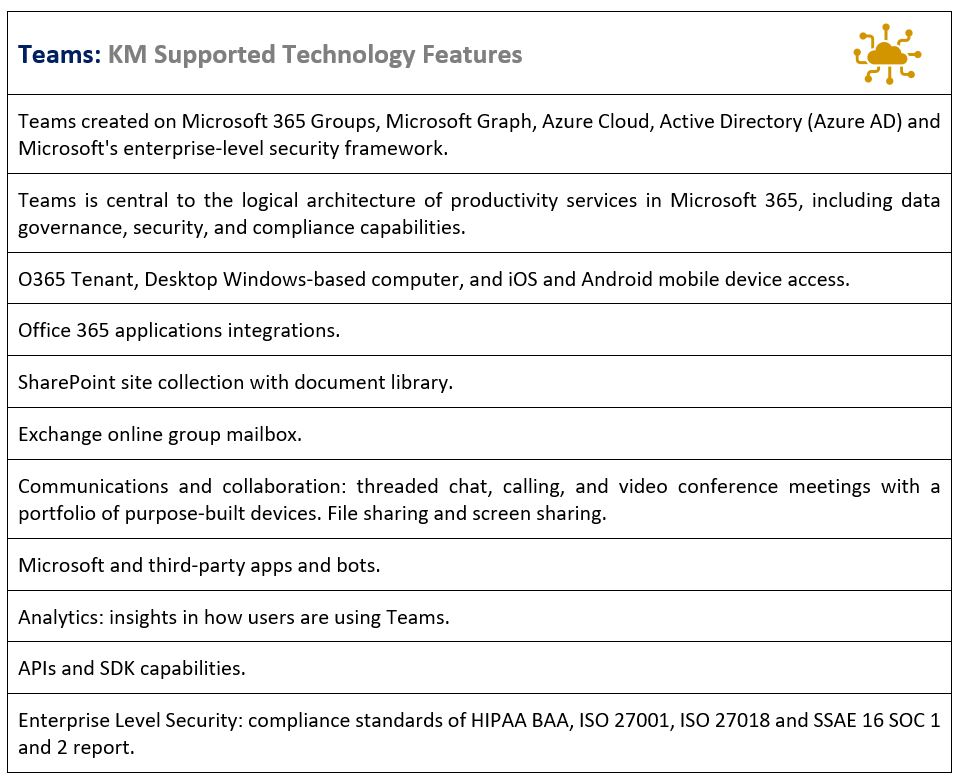
Teams provide the technology environment for business colleagues to connect digitally and with customers anywhere, seamlessly on any device via chat or audio and video calls and meetings, sharing and collaborating on documents and workflows securely within a real-time environment.
Learning
Research supports that Gen Y and Z members significantly favor personalized on-demand training. Many businesses and public sector organizations have yet to understand the need to modernize their learning experiences. Employees are the critical organizational repository of tacit knowledge and consumers and owners of explicit knowledge. Intellectual capital requires continual enrichment with practical learning and knowledge-building skills to retain its intrinsic value.
In the modern workplace, KM and learning approaches need tethering, within the organizational context, as they both feed and support each other in value creation activities. When knowledge becomes obsolete or neglected, the value of the employees' competencies and skills declines, business success is at risk and training, and employment of ad-hoc knowledge acquisition events may not prove for a positive turnabout.
A knowledge-learning organization focus includes:

Shown below are the Team's solution KM-focused e-learning capabilities.

Microsoft announced a future launch of a new Teams learning app, later this year, to help organizations improve the deployment of quality and cost-effective training. Microsoft's goal is to use Teams to facilitate a continuous feedback loop between work, skills, and learning and keep employees competent, in their positions, with personalized learning programs delivered in the flow of work.
The app will enable organizations to integrate content from LinkedIn Learning, Microsoft Learn, their learning and knowledge-building assets, and material from other providers all in one centralized virtual place, supporting instructor-led training to micro-learning experiences. Managers can track participants learning progress and results and offer instant feedback and recognition, and employees can schedule Team conversations with other participants to enrich the learning experience further.
Teams KM Approach Benefits
Collective research of Teams adoption reports successful set-up and deployment with broad worker acceptance and realization of benefits precisely from KM activities from a majority of users. The below table provides a reference point of the high-value benefits potential resulting from the use of the Team's solution to support knowledge-handling activities.
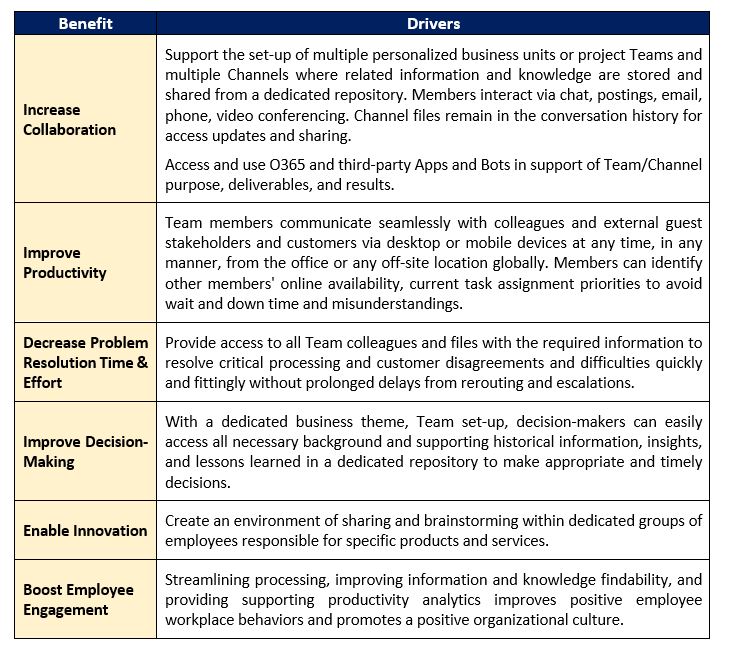
“Why waste knowledge? No company can afford to waste knowledge. Failure of management to break down barriers between activities is one way to waste knowledge. People that are not working together are not contributing their best to the company. People as they work together, feeling secure in the job reinforce their knowledge and efforts. Their combined output, when they are working together, is more than the sum of their separate.”
W. Edwards Deming
Teams and the SECI Knowledge Model
Ikujiro Nonaka and Hirotaka Takeuchi in 1996 introduced the SECI (Socialization, Externalization, Internalization, Combination) Model, which has become the cornerstone of knowledge creation and transfer theory. The Model's four pathways purport that tacit and explicit knowledge can be converted and combined, showing how knowledge is shared and created in an organization setting. The spiral in the Model indicates that knowledge expands and enhanced after completion of a loop.
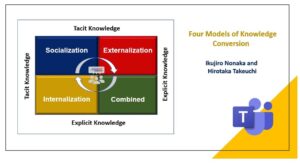
The Tacit and Explicit Dilemma
Tacit Knowledge is personal and context-specific; it is hard to formalize and communicate by human beings that acquire by actively creating and organizing their own experiences.
Conversely, Explicit Knowledge can be expressed in words and numbers and easily communicated and shared in documents and reports, scientific formulae, codified procedures, and universal principles.
It is widely accepted that 80% of knowledge is Tacit and 20% Explicit.
An analysis of Teams with the SECI Knowledge Model revealed that Teams comprise the capabilities to effectively manage tacit and explicit knowledge creation and conversion activities, as highlighted below.
- Empower employees by enabling self-serve, more efficient information and knowledge search and sharing, employee engagement measurement, and on-demand learning and development pursuits.
- Optimize and leverage business activities with effective business processes execution, delivery management, and tracking of customer products or services.
- Improve the quality of customer interactions by facilitating proactive and timely feedback loops, customer support, and sales productivity measurement.
Shown below are the SECI Model Pathways and how they are supported with the Teams solution

Organizational knowledge is a social experience generated and shared among a network of employees, customers, and partners, facilitated with a selection of technologies. Such social connections function on an assortment of formal and informal enterprise channels that are not always easy to detect and use. In a business setting, knowledge is only beneficial and produces value when it is recognized, accessible, and shareable with colleagues. This condition highlights that formal communication and collaboration practices, within a dedicated KM-supported ecosystem, are crucial for knowledge strategy effectiveness.
As the hub for practical teamwork, a Team's business unit or project set-up is where employees, including customers and others from outside the organization, can actively connect and collaborate in real-time. A Teams community has a bias toward KM as the place to have informal chats and calls, iterate quickly on a project, brainstorm new ideas, and collaborate on shared deliverables. Colleagues interacting, whether co-authoring a document, conducting a meeting, or working together in other apps, provides a platform for the generation of and conversion of new knowledge.
"An organization's ability to learn, and translate that learning into action rapidly, is the ultimate competitive advantage."
Jack Welch
The Way Forward
At Knowledge Compass, we bring together nearly four decades of thought leadership in business and technology strategy, the latest tools and best practices, and a seasoned consultant team with the competencies and talent to help our clients improve productivity and profitability.
Knowledge Compass explores and develops valuable new insights from business, technology, and science by embracing the powerful technology of ideas and brainstorming. Our consultants engage customers in challenging discussion and experimentation to expand business science boundaries and practice and translate creative ideas into practical solutions from within and beyond business.
Working with Knowledge Compass means a collaborative approach to understanding your current business model, strategies, and critical business requirements and goals.
We enable organizations to transform and deliver improved value by ensuring employees adapt and make the most effective use of knowledge management practices in culture, strategy, infrastructure, and processing. Our consultants have a deep understanding of the social and business factors that support a KM culture aligned with the corporate strategy and goals.
Knowledge Compass provides consulting services using an array of Frameworks, Analyses Tools, and Interactions from their Best Practices Consultant Toolbox.
